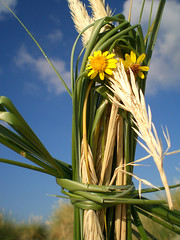So what exactly is Lammas? Good question! The Celts called it Lughnasadh, named for the Celtic sun god Lugh while the Saxons had it Hlaf maesse or Leff messe and later loaf mass which loosely means first bread so a celebration of the first fruits of the harvest would be a good way of describing Lammas.

However, that would be like describing Christmas as a time of binge drinking! Hmm … perhaps not a good comparison as there was plenty of that going on too! Anyway, you get the drift. Lammas, at least to our ancestors was a hugely important celebration as it marked the end of the growing season and the ripening of the first fruits.
With our stuffed full supermarkets and takeaways, it’s difficult to appreciate what this meant to our agrarian ancestors who often experienced a “hungry gap” during the early summer when last year’s stores ran low and the burgeoning harvest had yet to ripen.
Not surprisingly, the growing crops were anxiously watched and once the first fields of corn ripened, they were quickly harvested and the grains made into bread. These first loaves figured prominently in various pagan ceremonies throughout the world, most of which are now lost. Some of the rites did survive and many churches held or still hold a Lammas service where the first bread of the harvest is blessed.
Later day pagans of course have their own ceremonies and as do many other lovers of the natural world that still have a sense of connection to the great wheel of life, endlessly repeating its message of death and rebirth.
With the success or otherwise of the harvest being so crucial to winter survival it is little wonder our ancestors were not above a little bribery, offering the gods the first fruits of their efforts in the form of corn dollies.
You will no doubt have been told or read that corn dollies were made from the last remaining stands of corn where it was said the earth mother or spirit of the corn dwelt. This is quite true, but what is not generally realised is that corn dollies or corn babies were also made at the beginning of the harvest as good luck charms or as some think, offerings of appreciation (or supplication to fickle gods).
You can often see a remnant of this custom amongst country folk even now when crusts and crumbs are shared with the wild folk of the hedgerows. (Birds as we know, being messengers of the otherworld, should always be treated with the greatest respect!)
Harvest still remains an anxious time, even for those of us in the developed world. In spite of our cleverness, we are always at the mercy of the weather and within hours a whole crop can be laid waste under the wrath of a violent thunderstorm or be reduced to ashes by a lightening strike. In the uncertain world of our rural dwelling ancestors, the precariousness of the harvest was even more of an issue which is why the celebrations were often loud, raucous, rowdy and greatly aided no doubt by some of those first grains being fermented into something warming and decidedly consciousness altering so let's raise a toast to old Barleycorn and a bumper harvest!
